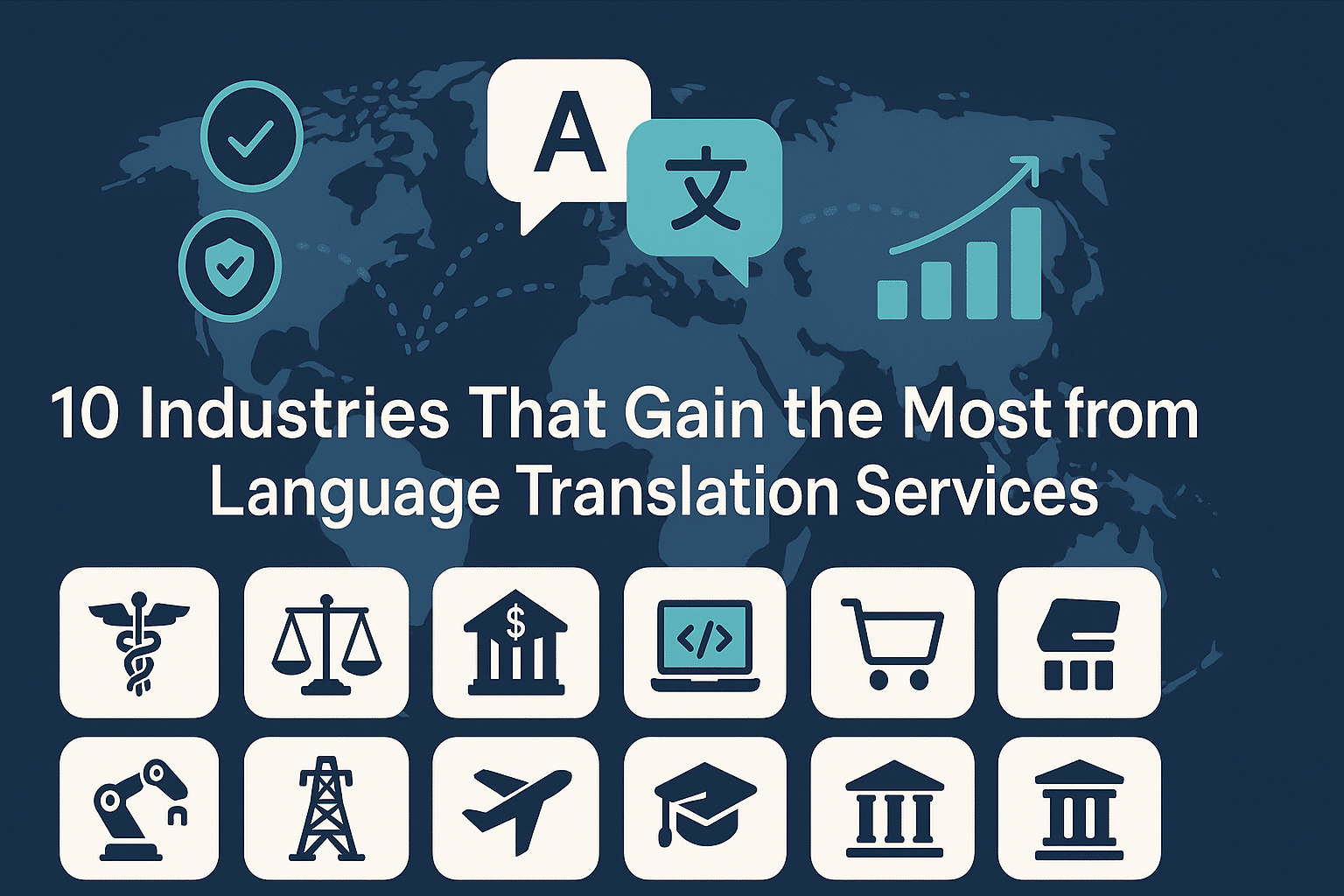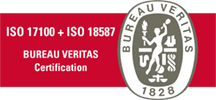10 Industries That Gain the Most from Language Translation Services
Language translation services help companies scale trust, revenue and compliance across markets. Below we map the 10 sectors with the fastest, clearest ROI and how to act.

Table of Contents
Why language translation services change outcomes
Expanding into new regions isn’t just about words—it’s about lowering the friction customers feel when they try to buy, comply, or get support. A capable partner connects terminology, legal nuance, and product context so multilingual content reads as if written locally. That reduces abandonment, disputes, and rework.
Across regulated sectors, accuracy is a risk-control mechanism. Translators who specialise in legal, financial, scientific, and technical domains apply field-specific style guides and terminology management. That keeps documents consistent and audit-ready. When your needs are broad, a services hub such as translation services helps align deliverables with business intent.
The compounding gains from language translation services
The benefits multiply over time. Glossaries and translation memories accelerate delivery while preserving tone of voice across web, apps, contracts, manuals, and support. Quality frameworks (for example, ISO 17100 certification and ISO 18587) reduce variance and make outcomes predictable. When the content is complex—think patents, compliance filings, or safety manuals—specialised pages like legal translation or technical translation ensure you’re assigning the right linguists.
Authoritative context: for public-sector and cross-border projects, consult the European Commission’s language resources on Europa for policy and tooling guidance (commission.europa.eu/languages). For standards-driven work, see ISO’s overview of translation quality (iso.org).
How to evaluate providers
Start with scope clarity: languages, content types, volumes, and review cycles. Look for native linguists and second-review steps to catch subtle errors. Ask how glossaries are built and maintained, and how change requests flow into future updates. Explore turnaround commitments, especially for recurring releases.
Evidence matters. Read independent client testimonials to stress-test claims. For regulated work, confirm standards and post-editing practices for machine-assisted workflows. When in doubt, start small and expand once quality, speed, and budget align, then fast-track with a clear CTA like request a quote.
The 10 sectors that benefit most
Below are the industries where translation delivers outsized returns—through revenue capture, risk reduction, or operational efficiency.
1) Legal & Compliance
Cross-border contracts, litigation packs, privacy notices, and HR policies must be unambiguous. Specialist teams handle citation formats, exhibits, and sworn wording. Pair your counsel with a provider experienced in legal translation to protect enforceability and deadlines.
Authoritative reference: EU law texts are published on EUR-Lex, the official portal for EU legal documents (eur-lex.europa.eu).
2) Technical & Manufacturing
User manuals, maintenance guides, and safety data sheets require exact terminology and layout fidelity. Consistent terminology prevents warranty claims and downtime. Leverage a team focused on technical translation with glossary control and DTP support.
3) Life Sciences & MedTech
IFUs, clinical trial documentation, and pharmacovigilance reports are audited. A documented QA chain tied to ISO 17100 reduces risk and speeds submissions. For post-editing requirements, align with ISO 18587).
Authoritative references: the European Medicines Agency publishes multilingual guidance for product information (ema.europa.eu); in the US, the FDA provides medical-device labeling and language guidance (fda.gov/medical-devices).
4) Financial Services & Fintech
Prospectuses, KIDs, T&Cs, and investor reporting need precision and version control. Terminology errors can mislead consumers and trigger penalties. Engage a specialist in financial translation with strict change-log practices.
5) Enterprise Software & SaaS
UI strings, release notes, and help centres require continuous localisation that matches sprint cadence. Glossaries keep UX consistent across languages. A generalist partner with a strong translation services backbone plus engineering-friendly workflows is ideal.
6) E-commerce & Marketplaces
Product listings, buyer protection policies, and support macros drive conversion and reduce disputes. Even a 1–2% uplift at scale is material. Language-pair pages such as Portuguese to English translations and English to Portuguese translation help merchants expand quickly.
7) Public Sector & NGOs
Grant applications, public tenders, and citizen-facing portals need clarity and accessibility. Transparent QA and published terminology lists build trust. Consider linking to institutional references and offer multilingual feedback loops.
8) Energy & Engineering
Blueprints, tender specs, and commissioning procedures mix narrative and numeric data. Terminology accuracy supports safe operations. Teams with sector glossaries and a critical review step catch costly misreads before they propagate.
9) Education & EdTech
Courseware, assessments, and parental communications require age-appropriate register and cultural fit. Translation memories reduce per-unit costs across semesters while keeping tone consistent.
10) Marketing & Corporate Communications
Campaigns, executive letters, and CSR reports must sound local, not translated. Native copy adaptation supported by business translation preserves nuance while aligning to brand voice.
What to operationalise in the first 90 days
A market-first playbook for your organisation:
- Prioritise by impact and risk. Inventory high-visibility and high-liability content (contracts, safety, regulatory, product UI) and rank by market size and compliance deadlines.
- Define audiences and journeys. For each target country, map the moments where language clarity reduces friction (discovery, purchase, onboarding, support).
- Create a living terminology base. Nominate subject-matter owners to validate key terms, product names and abbreviations; publish a style guide for tone, date/number formats, and units.
- Build the review circuit. Decide who signs off by content type (legal, technical, marketing) and set SLAs for draft, review, and final approval.
- Localise the critical path first. Ship the top five artefacts that unblock revenue or compliance (e.g., T&Cs, safety sheets, homepage, checkout, support macros).
- Engineer for reuse. Store approved phrases in a central memory; standardise file formats and templates to eliminate rework across teams.
- Instrument the rollout. Track conversion in new locales, dispute rates, and time-to-publish; set quarterly targets and review exceptions.
- Close the loop. Capture feedback from sales/support in each market; publish a simple “what changed” note after each release to keep stakeholders aligned.
- Document compliance references. Record which standards/regulators apply per market (e.g., ISO 17100, EMA, FDA) and keep links handy for auditors (ema.europa.eu, fda.gov).
- Scale deliberately. Once KPIs are met, expand languages and content types; avoid one-off exceptions that dilute quality.
For high-stakes documents (diplomas, court filings, immigration), consider certified translations so authorities can verify translator qualifications.
Measuring impact beyond word counts
Track three families of metrics: revenue (conversion and average order value in new locales), risk (audit findings, dispute rates), and efficiency (cycle time, rework). Supplement quantitative data with qualitative feedback from sales and support. When you need a broader partner, vet the translation company behind the service quality, not just the per-word rate.
Cite external standards to align teams: see ISO’s overview of translation quality (authoritative guidance at iso.org) and best-practice introductions from neutral bodies such as the European Commission’s language resources (Europa) for public-sector projects.
FAQ
Q1. How do language translation services differ from simple bilingual review?
Bilingual review focuses on surface-level correctness in a single document. Language translation services deliver an integrated process—terminology management, style guides, double review, and change control—across many document types and releases. That means fewer surprises when content is republished or audited months later.
Another difference is accountability. Service providers align to standards such as ISO 17100 and ISO 18587, which formalise roles, competencies, and workflows. With that groundwork, you can scale volume and maintain tone across legal, technical, and marketing content without renegotiating quality on every job.
Q2. When should I choose certified translations?
Choose certified translations when the receiving authority demands proof of translator credentials or sworn statements—common for academic records, immigration, and court exhibits. “Certified” isn’t about better prose; it’s about acceptance and traceability, which saves time and avoids resubmissions.
If your documents will be presented abroad, check the authority’s instructions first. When in doubt, ask your provider to confirm whether certification is required for your jurisdiction and document type before starting the project.
Q3. What’s the right way to budget for ongoing localisation?
Treat localisation as an operating capability. Set a baseline for predictable volumes (product updates, legal notices) and choose a variable pool for spikes (tenders, campaigns). Translation memories and glossaries reduce unit costs over time; you should see velocity gains and fewer rewrites after the first cycles.
Negotiate SLAs by content type rather than a single all-purpose deadline. For example, marketing copy may require more stakeholder review, whereas release notes can move faster with automated checks and a leaner sign-off.
Q4. How do I verify quality before committing?
Ask for a short pilot with representative files: a contract clause, a UI string set, and a safety paragraph. Request the changes tracked between first pass and review to see how the team handles nuance. Check references through client testimonials and verify certifications. If process clarity and responsiveness are strong, scale gradually and codify expectations in a service charter.

